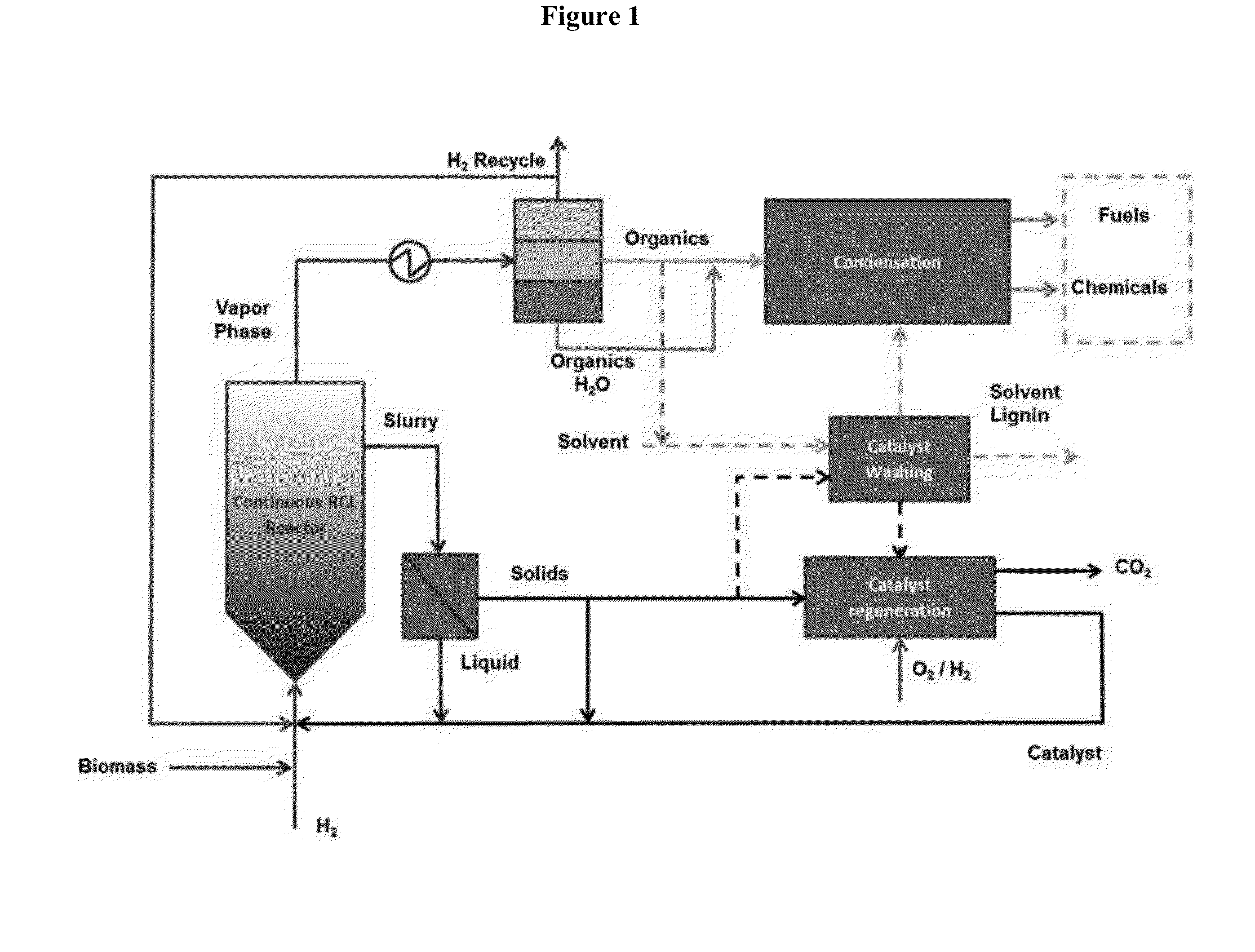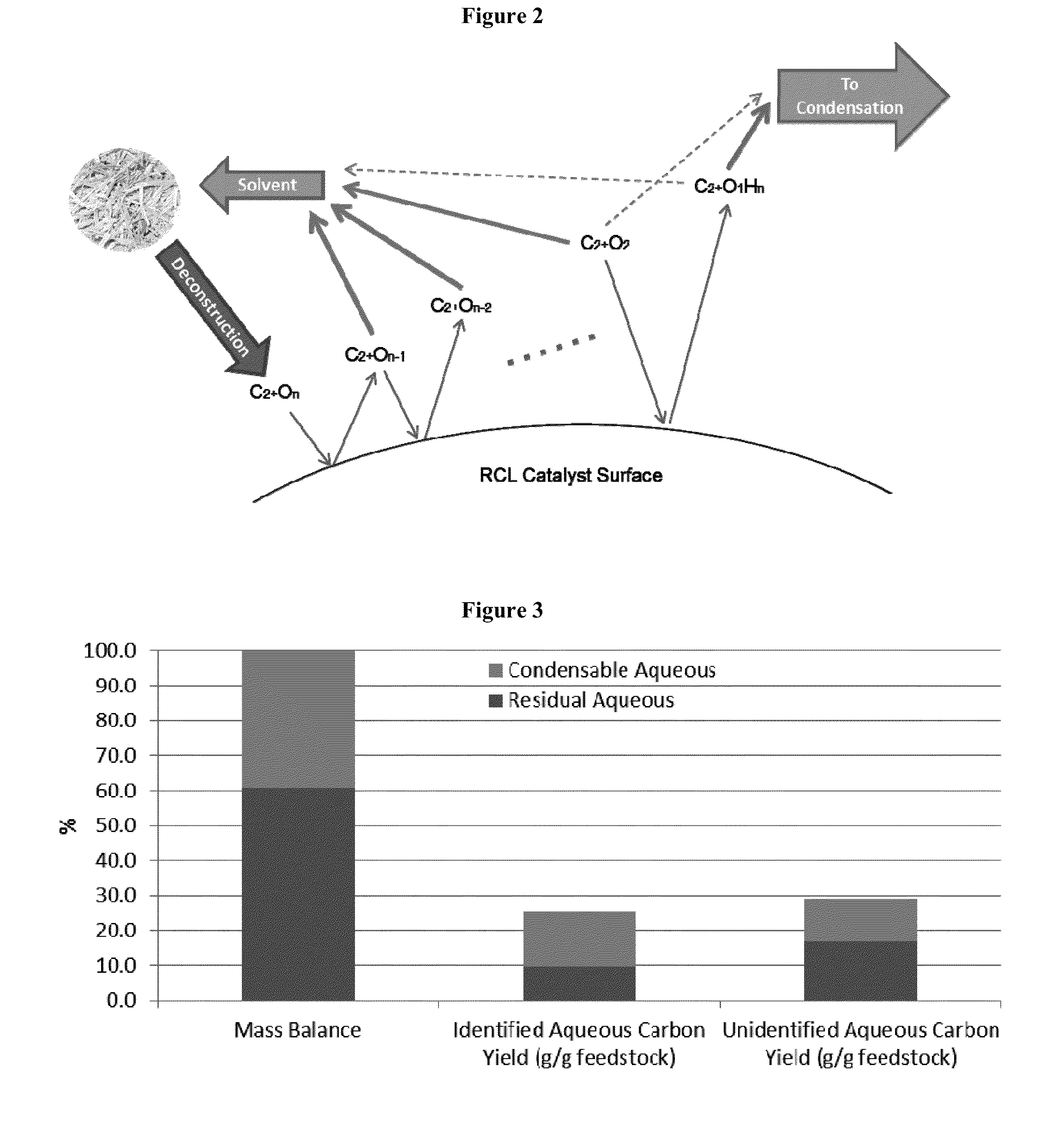Production of chemicals and fuels from biomass
a technology of biomass and fuel, applied in the field of catalysts, can solve the problems of inability to efficiently convert cellulose, hemicellulose and lignin to components, lack of cost-effective processes, and remaining fractions
- Summary
- Abstract
- Description
- Claims
- Application Information
AI Technical Summary
Benefits of technology
Problems solved by technology
Method used
Image
Examples
example 1
[0225]Product streams from the examples described below were analyzed as follows. The organic liquid phase was collected and analyzed using either gas chromatograph with mass spectrometry detection or flame ionization detection. Component separation was achieved using a column with a bonded 100% dimethyl polysiloxane stationary phase. Relative concentrations of individual components were estimated via peak integration and dividing by the sum of the peak areas for an entire chromatogram. Compounds were identified by comparison to standard retention times and / or comparison of mass spectra to a compiled mass spectral database. Vapor phase compositions, for the non-condensable species, were determined by gas chromatography with a thermal conductivity detector and flame ionization or gas chromatography with a flame ionization detector or mass spectrometry detectors for other vapor phase components (e.g., aqueous or organic phase condensable species). The liquid phase fraction was analyze...
example 2
[0226]A biomass feed stream containing 10% (w / v) microcrystalline cellulose (MCC) in water was converted to a gas phase containing volatile C2+O1-2 oxygenates and a liquid phase using modified palladium on tungstated-zirconia oxide support. The conversion was carried out in a 300 ml Parr reactor at 260° C. and 1000 psi H2, with a 15 minute reaction time. The reaction included a catalyst:biomass ratio of 1:3.
[0227]Hydrogen sparging and constant mixing at 800 rpm was used to increase mixing and catalyst contact. Mixing occurred from the start of heating to the end of cooling. The constant sparging allowed volatile C2+O1-2 oxygenates to be collected overhead and separated from the residual aqueous products left in the reactor. Both liquid phase and vapor phase products can be seen in FIGS. 3, 4a, 4b, and 5. FIG. 3, in particular, provides the overall conversion and selectivity. The condensed vapor stream contained C2+O1-2 oxygenates as shown in FIG. 6 and in Table 1 below. Non-condensa...
example 3
[0229]A biomass feed stream containing 12-17% (w / v) loblolly pine in water was converted to a gas phase containing volatile C2+O1-2 oxygenates and a liquid phase using modified palladium on a tungstated-zirconia oxide support. The conversion was carried out in a 300 ml Parr reactor at 280° C. and 1000 psi H2, with a 15 minute reaction time. The reaction included a catalyst:biomass ratio of 1:3.
[0230]Hydrogen sparging and constant mixing at 800 rpm was used to increase mixing and catalyst contact. Mixing occurred from the start of heating to the end of cooling. The constant sparging allowed volatile C2+O1-2 oxygenates to be collected overhead and separated from the residual liquid phase products left in the reactor. The volatile oxygenates collected were then condensed and analyzed. Less volatile residual liquid phase products were collected after the reactor was cooled and similarly analyzed.
[0231]The results of the analysis of both the vapor phase and liquid phase products are prov...
PUM
| Property | Measurement | Unit |
|---|---|---|
| deconstruction pressure | aaaaa | aaaaa |
| temperature | aaaaa | aaaaa |
| density | aaaaa | aaaaa |
Abstract
Description
Claims
Application Information
 Login to View More
Login to View More - R&D
- Intellectual Property
- Life Sciences
- Materials
- Tech Scout
- Unparalleled Data Quality
- Higher Quality Content
- 60% Fewer Hallucinations
Browse by: Latest US Patents, China's latest patents, Technical Efficacy Thesaurus, Application Domain, Technology Topic, Popular Technical Reports.
© 2025 PatSnap. All rights reserved.Legal|Privacy policy|Modern Slavery Act Transparency Statement|Sitemap|About US| Contact US: help@patsnap.com



